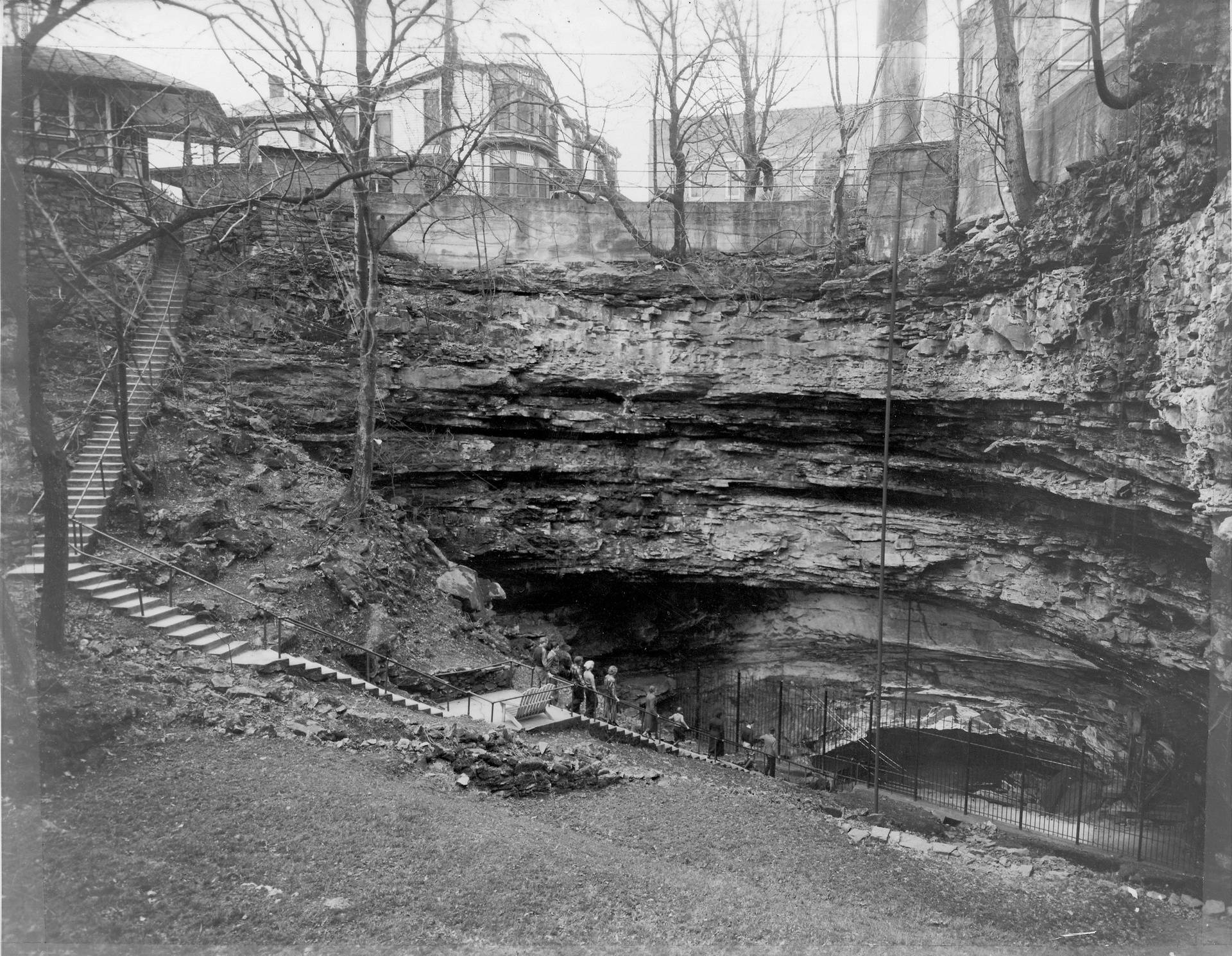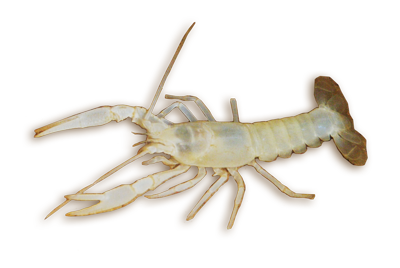Historic Hidden River Cave

The Story of Hidden River Cave
Horse Cave was a vibrant community that was founded around 1850 on the land surrounding the scenic entrance to the cave. The cave stream provided drinking water and hydroelectricity for the City of Horse Cave. In 1916 a local contest was held to rename the cave and the name “Hidden River Cave” was chosen. Public cave tours into Hidden River Cave were offered from 1912 through 1943. Tourists came from all around to see Sunset Dome the “largest unsupported roof dome in the world” and the eyeless fish, “curious creatures of darkness, found originally only in Hidden River Cave.” (source: historic Hidden River Cave brochure c. 1930s)
As early as 1879, attempts were made to set up a public waterworks in the cave allowing the cave stream to provide drinking water to the community above.
In 1888, Dr. George A. Thomas moved to Horse Cave to establish a dental practice. He envisioned the cave as both a source for water and electrical power. Water from a spring in the north wall of the cave entrance was caught in a wooden tub and hauled up to a brick spring house by a clever bucket trolley. Later, the south branch of the cave stream itself became the source of water for the town and the power to lift it to a standpipe located on the lip of the cave entrance.
In 1890, an ingenious vertical shaft turbine was erected below the confluence of the two cave streams to power a piston pump located near stream level and a booster pump located halfway to the surface. A large, grooved wheel with an endless cable powered the top pump. The addition of an electrical generator in 1892, provided electricity to the Thomas home, dental office, and two other buildings in town. This gave Horse Cave the distinction of being the first town in Kentucky to have incandescent lights. (Louisville, Kentucky was illuminated by electric arc lights earlier).
As the community grew, local residents dumped their trash and injected sewage waste into sinkholes, shallow wells and cave passages that lie under the city. No one realized that by doing this, they were actually contaminating their own water supply and that this would eventually lead to the pollution and closing of Hidden River Cave. By the mid-1930s, the town’s water supply was hopelessly polluted, and in 1943 noxious odors emitted by the cave’s pollution caused the closure of the tours. In addition to domestic sewage, wastes from local industries caused serious pollution and depletion of the cave stream’s oxygen. In the 1950s, vile odors permeated the entire business district of Horse Cave during the summer months, and the cave life completely died out.
1963 – the 1st Sewage Treatment Plant
To remedy this, the community constructed a domestic sewage treatment plant in 1963. Unfortunately, because they did not understand the relationship between above and below ground activities in cave and karst areas, wastewater from this new plant was dumped into dry wells. These funneled directly into the cave which made the pollution problem even worse. To add insult to injury, in 1975, thousands of gallons of gasoline were lost into the cave system from a leaking tank. Residents could smell the fumes in many local basements.
Hidden River Cave lay desolated for several decades. The cave streams once plentiful with eyeless fish could no longer support life with the exception of strings of sewage bacteria and writhing bloodworms that thrived in the nearly oxygen-free water. Thick vegetation grew in the cave entrance leaving it nearly invisible to passersby. In the cooler months it was easy to ignore the cave, but each summer brought the horrible stench of raw sewage from the entrance reminding residents of its presence.
The American Cave Conservation Association relocates to Horse Cave
In 1987 the American Cave Conservation Association (ACCA) relocated their national headquarters from Richmond, Virginia to Horse Cave at the invitation of William T. (Bill) Austin. Bill had approached two other caving organizations about creating an educational center at Horse Cave without success. As fortune would have it, ACCA was looking for a new home and jumped at the opportunity.
Bill was a visionary businessman who’s family originally owned Hidden River Cave, Mammoth Onyx Cave and had also owned Floyd Collins Crystal Cave before it became a part of Mammoth Cave National Park. He had watched the demise of Hidden River Cave and wanted to not only restore the cave for the benefit of the community, but he also saw this a perfect opportunity to raise public awareness about the importance of about cave conservation.
For the ACCA, a national nonprofit with a mission to protect caves, karstlands and groundwater, this was the perfect project and opportunity. The association immediately began fundraising and working to build public support for the regional sewage treatment facility as well as an educational center to be located in the entrance of the cave.
1989 – A New Regional Sewage Treatment System Brings Hope
In December 1989, sewage finally stopped flowing into Hidden River Cave when a new state-of-the-art sewage treatment system was built for the communities of Horse Cave and Cave City. This was part of a state and federally funded project to restore the groundwater quality to the whole region. The cave was soon on its way to naturally restoring itself. By the summer of 1991, numerous cave crayfish had migrated to the previously polluted sections of the cave to feast on the dying sewage organisms. The natural recovery process continued and more native cave animals began to once again colonize the the passageways and cave streams.
In 2013, Dr. Julian J. Lewis began a biological inventory of Hidden River Cave. The study found that Hidden River Cave’s once polluted passages were now home to twenty-one types of cave species, making the cave a global hot spot of subterranean biodiversity. In two decades, Hidden River Cave had transformed from one of the most polluted to one of the most biologically diverse cave ecosystems in the world.
By 2015, groundwater studies conducted by researchers from Western Kentucky University and Canada’s McMasters University concluded that Hidden River Cave’s water quality had recovered to near drinking water standards.

The Opening of the American Cave & Karst Center
In 1992, cleanup efforts Hidden River Cave’s large sinkhole entrance began to restore the lush setting described by John Muir after his 1867 visit. Exploration and mapping of the cave also resumed under the leadership of the ACCA after a 50-year hiatus. The full extent of the passageways is still unknown. In addition, plans to reopen the cave were considered. The first stage was accomplished in 1992 by improving the steps and walkway to the underground river.
Also, in 1992, the American Cave and Karst Center was established in historic buildings at the mouth of Hidden River Cave, once again calling attention to this remarkable natural feature: remarkable for its unique setting, it’s inherent beauty, its quintessential geology, and the successful rejuvenation of its underground river system.
As funding became available, progress continued on the expansion of the cave tour. The ultimate goal was to once again bring visitors to the large room known as Sunset Dome.
In November 2018 construction was completed on the world’s longest underground swinging bridge. The bridge spans 100 feet across a 50-foot-deep canyon. By the Fall of 2019, the new Hidden River Cave tour was about three quarters completed. An anonymous gift allowed ACCA to finish the tour to Sunset Dome in February 2020. Sunset Dome was now accessible after being closed for 76 years!
The American Cave & Karst Center is now known as the American Cave Museum. Today thousands of visitors and school children tour the museum and Hidden River Cave annually. Exhibits and guided tours tell the story of cave’s remarkable recovery and help to create an understanding and appreciation for fragile caves and their resources.
Securing the Cave’s Protection
Although Hidden River Cave was an amazing success story, there were still a few complex obstacles to overcome to ensure its protection.
The cave’s history showed how vulnerable it was to above ground activities. While the cave was continuing to recover, the American Cave Conservation Association (ACCA) had begun to search in earnest for a way to permanently protect the cave. In 2012, ACCA secured funding from the Kentucky Heritage Land Conservation Fund to conduct an appraisal and purchase the cave rights. A year of complex negotiations followed with CSX Railroad who owned the cave rights and two local businesses that owned the surface rights.
In November 2005, the Mayor of Horse Cave joined state officials and the surface and subsurface cave property owners at the American Cave Museum to sign an easement to protect Hidden River Cave in perpetuity.
Thank You for Reading!
For more in-depth information about Hidden River Cave and photos, we encourage you to visit us in person or to visit our www.hiddenrivercave.com website.
Hidden River Cave & The American Cave Museum are operated by the American Cave Conservation Association, A National 501 (c) 3 Nonprofit Organization.
